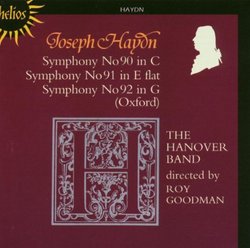| All Artists: Franz Joseph Haydn, Roy Goodman, Hanover Band Title: Joseph Haydn: Symphony No. 90 in C; Symphony No. 91 in E flat; Symphony No. 92 in G (Oxford) Members Wishing: 1 Total Copies: 0 Label: Hyperion UK Release Date: 8/12/2003 Album Type: Import, Original recording reissued Genre: Classical Styles: Historical Periods, Classical (c.1770-1830), Symphonies Number of Discs: 1 SwapaCD Credits: 1 UPC: 034571151250 |
Search - Franz Joseph Haydn, Roy Goodman, Hanover Band :: Joseph Haydn: Symphony No. 90 in C; Symphony No. 91 in E flat; Symphony No. 92 in G (Oxford)
 | Franz Joseph Haydn, Roy Goodman, Hanover Band Joseph Haydn: Symphony No. 90 in C; Symphony No. 91 in E flat; Symphony No. 92 in G (Oxford) Genre: Classical |
Larger Image |
CD DetailsSimilar CDs |
CD ReviewsExploring the Haydn Symphonies -- Nos. 90,91,92 Robin Friedman | Washington, D.C. United States | 03/22/2006 (5 out of 5 stars) "Beginning with the Paris symphonies of 1785 -- 1786, (no. 82-87), Haydn's work assumed a new degree of originality and mastery as he composed for parties other than his Esterhazy patrons. Between the Paris symphonies and the final group of twelve London symphonies, Haydn composed six symphonies (no. 88-92) for Parisian patrons. This CD includes three of these works, symphonies 90, 91, and 92. They show Haydn composing at an extraordinary level with a breadth of invention and variety in three highly individual works.
Roy Goodman conducts the Hanover Band on this CD, which is a reissue of recordings made during the early 1990s. The performances are on period instruments and use a harpsichord continuo. Although Goodman did not record the entire Haydn cycle of symphonies, those he did complete, including those on this CD, are of a high order. They are also available at a low price. The best-known work in this collection is the symphony no 92 in G major, the "Oxford" symphony. Haydn wrote this work for a French patron, but he conducted it in 1791 during his first trip to London when he received an honorary degree from Oxford. This work shows that Haydn the honor was amply deserved. The work is beautifully integrated and expansive -- as Haydn develops and embroiders the ideas of each of the movements in elaborate recapitulations. The opening movement begins with a quiet, pensive slow introduction followed by a joyous, quick allegro spiritoso -- based upon the theme utilized in the introduction. The work includes a short, counterpointed development section followed by a recapitulation which is in effect a second development section as Haydn enlarges upon his opening ideas. The adagio consists of a quiet and serene theme in the strings and horns interrupted in mid-course by a tempestuous section in the minor. When the opening section returns, it is embellished greatly with beautiful passages for the wind band. The third movement is an energetic minuet which recalls the opening movement and which includes a dramatic pause as the theme runs its course. The trio features an opening horn call and, when the theme of the minuet returns, it is again subjected to extended development. The finale opens quietly with an elaborate, dramatic second subject. There is a great deal of original orchestration as the theme is developed by the strings and winds. Again, Haydn elaborates upon his themes greatly during the recapitulation to bring the symphony to an inspired close. The Oxford symphony is well-known, but Haydn's symphony no. 91 in E-flat major is a gem waiting for the new listener to discover. This is a quiet, subdued and introspective work, rather unusual for an entire Haydn symphony. It also features a great deal of dance music. After a lyrical slow introduction, Haydn introduces a quiet theme which is developed with counterpoint and elaborated. The flute plays a prominent role in this movement. The second movement is a theme and variations with many surprising shifts of key, and with a new theme in the minor key introduced in mid-movement. The final repetition of the theme includes a great deal of filigree and trilling as it works to a quiet, elegant close. The minuet is based upon a graceful dance theme and the trio is a waltz with an oom-pah-pah accompaniment. The finale opens quietly but works to a spirited close. This work is one of my favorite lesser-known Haydn symphonies that I have discovered in the course of my listening. It is also available on a Naxos CD together with symphonies 69 and 89, conducted by Bela Drahos with the Esterhazy Sinfonia. I prefer Goodman's version. Haydn's symphony no. 90 in C major is a ceremonial, flamboyant work, in common with Haydn's other symphonies in this key. It thus forms a marked contrast to no. 91. The work opens with a large-scale slow introduction featuring heavy chords followed by a lively allegro which, again, shows Haydn integrating his introductory material with his primary theme. There are some exhilirating, flashy scale passages during the course of the expanisve opening movement. The second movement presents two themes, the first in the major the second in the minor, both of which are subjected to variations. There is a lovely variation for flute solo and another variation in which the cello takes the theme under a violin accompaniment in triplets. The graceful minuet is followed by a trio featuring the oboe. The most unusual movement of this work is the finale, which proceeds at a lively ceremonial pace until a dramatic, lengthy false ending late in the movement. The music then resumes quietly, almost bashfully, until Haydn eventually works back to a ceremonial, virtuosic close. I hope you will enjoy these three symphonies of the mature Haydn, beautifully performed. Robin Friedman" |



